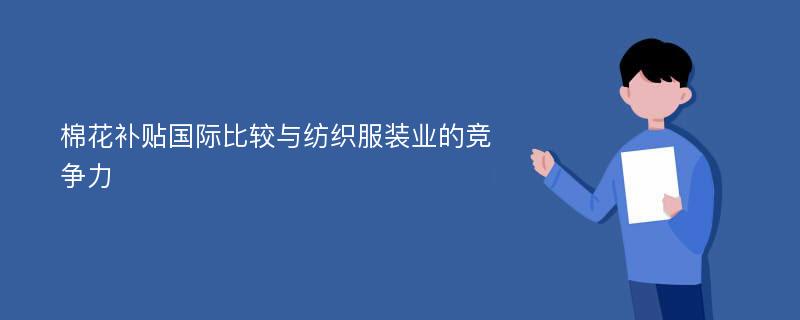
论文摘要
在世贸组织多哈会谈中,农业补贴是人们关注的焦点。棉花补贴的种类和补贴程度,国与国之间补贴的差异,是造成农业补贴争论的重要原因。纺织品配额取消后,作为纺织品服装业的主要原料之一,棉花需求和生产会有一定程度的变化,我国棉花政策对其补贴是否符合时代变化的要求值得探讨。 纺织品配额的取消促进了纺织服装业的贸易自由化。作为纺织品服装生产和消费大国,中国如何在纺织服装业一体化过程中进一步提高竞争力,成为一个重要的研究课题。 本文第一章介绍了农业补贴的一般情况,农业补贴的定义、分类,并分析了其存在的原因和影响;第二章介绍了棉花补贴情况,主要对美国、欧盟等国家和地区的棉花补贴形式和程度进行了详尽的比较分析,同时对中国的棉花补贴进行了分析和评估,并对棉花补贴的影响作了总结;第三章对棉花的需求和供给作了必要的阐述;随后,本文第四章介绍了世界纺织品服装业的概况,分析和阐明了中国纺织品服装业自身的问题和纺织品配额取消后的竞争环境;第五章,分析了中国纺织品服装业贸易面临的问题,指出提高中国纺织品服装业竞争力的途径与方法。
论文目录
ABSTRACT摘要CONTENTSChapter 1 Brief Introduction on Agricultural Subsidy1.1 Definition of Agricultural Subsidy1.2 Classification of Subsidies and WTO Rules1.2.1 Classification1.2.2 WTO Regulation1.3 Reasons for Agricultural Subsidy and Impacts1.3.1 Reasons for Agricultural Subsidy11.3.2 Impact of Agricultural SubsidiesChapter 2 Global Comparison on Cotton Subsidy2.1 Current Situation2.2 Cotton Subsidy Comparison2.2.1 America Cotton Subsidy2.2.2 EU's Cotton subsidy and Its Reform2.2.3 Other Countries' Subsidy2.2.4 WTO Commitment and China's Cotton Subsidy6'>2.2.5 Evaluation of China's Cotton Policy62.3 Impacts of Cotton Subsidy2.3.1 Rich Countries' Cotton Subsidy Impacts2.3.2 Impacts of Developing and Least developed countries' Cotton Subsidy2.4 Ruling Against US Subsidy and Its Implications2.4.1 WTO Ruling Against US Cotton Subsidy2.4.2 Implications2.5 Future of Cotton SubsidyChapter 3 Market Demand and Supply for Cotton3.1 Cotton Supply3.2 Cotton DemandChapter 4 Textile & Apparel Trade4.1 Textile & Apparel Trade4.1.1 World T&A Trade4.1.2 China's T&A Trade4.2 New Tendency of T & A Trade4.2.1 Textile Quota Removal4.2.2 Great Market Opportunity After Quota Removal9'>4.2.3 Green and Environmental Demand for Eco-textile & Apparel Goods94.3 Issues and Dynamic Environment Facing T&A Industry4.3.1 Low Level of Technical Equipment and Productivity4.3.2 Unfavorable Product Structure4.3.3 Low Added Value of T&A Industry4.3.4 High Material Cost"12'>4.3.5 Problem Resulted from Decoupled Drawback124.3.6 Non-green Situation of Textile Goods4.3.7 Impact of Exchange Rate Appreciation4.4 External Environment4.4.1 Fierce Competition4.4.2 Increased Trade Barriers4.4.3 GSP Scheme Under Change and Its Impacts4.4.4 Istanbul Announcement4.4.5 Domestic Impingement from Foreign Enterprises' CompetitionChapter 5 Relation Between Competitiveness of China T&A Goods and Cotton Subsidy5.1 Solving Issues to Enhance Competitiveness of T&A Industry5.1.1 Upgrading Production Technology5.1.2 Optimization of Product Structure5.1.3 Sufficient Preparation for Possible Barriers5.1.4 Barrier Circumvention5.1.5 Anti Special Safeguard Measures5.1.6 Cooperation Between Government and Enterprises5.1.7 Meeting Demand for Eco-textile Goods5.2 Impacts of Cotton Subsidy on Competitiveness of T&A Goods5.2.1 Economic Impacts on China's T&A Industry5.2.2 Scientific and Environmental Impacts5.2.3 More Green Box MeasuresREFERENCEACKNOWLEDGEMENT
相关论文文献
标签:农业补贴论文; 国际比较论文; 竞争环境论文; 竞争力论文;

